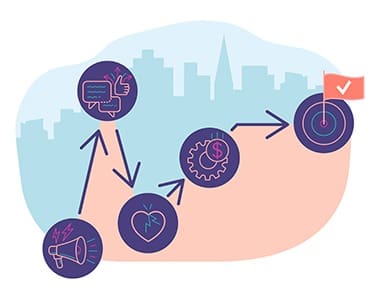Social Justice: Business Disruptor or Hype Cycle?

Listen to the Audio Podcast
We are currently living through a period of intense social upheaval. People are taking to the streets in every major city across the country, protesting injustice towards BIPOC, women, and the LGBT+ community – committed by their own federal and local governments.
It’s the kind of upheaval that can change a society forever, and in some places the protests are seeing results; 13 U.S. cities have cut funding from their police departments in light of the protests, and the Supreme Court just ruled that the Civil Rights Act of 1964 offers protection to LGBT+ individuals, marking a new era in trans rights.
Things appear to be moving in an inclusive and progressive direction, but there’s just one problem: we’ve seen and heard all this before. What will make this time different?
I am both hopeful and skeptical that the Black Lives Matter movement and other protests will change the hearts and minds of business leaders to implement diversity, equity, and inclusion (DEI) in their culture. I believe that DEI is essential for every business, simple because of what I learned in business school: maximize the value for shareholders.
Companies that have one-sided workforces (all white, all male, etc.) will likely have a limited perception of the world. This can limit the way a workforce views a problem, keeping them from true innovation that disrupts their industries. If existing business leaders truly want to maximize the value of their business for their stakeholders, they will need to shift their culture and embrace DEI.
If business leaders approach social justice with an innovation lens, perhaps we can take an innovative view of this season of disruption.
The leaders would fit into one of the following groups:
- Innovators: These individuals seek out novelty; it’s like a hobby for them. They are limited in numbers. Other people see them use new things and feel braver themselves about trying them.
- Early Adopters (visionaries): Early adopters look for breakthrough opportunities, and they are willing to pay well to be first with the new approaches. This group relies on its own intuition and vision to make buying decisions.
- Early Majority: These are practical minded consumers. If an opportunity seems useful, this group will try it. The early majority are cautious of fads.
- Late Early Majority: These people wait for something to become well established. They don’t feel confident in their ability to deal with change and often buy from big companies.
- Laggards: For personal and/or economic reasons, laggards are not looking to buy into new change.

As businesses embrace DEI, their worldview will expand, and innovation will become easier. However, this doesn’t mean that growth will be a constant upward slope. As workforces become more diverse and innovation increases, the five innovation hype cycles may influence the behaviors of business leaders.
The Innovation Hype Cycles are:
- Innovation Trigger: A potential humanity breakthrough that kicks things off. Early proof-of-concept stories and media interest trigger significant publicity. Often no real outcomes exist, and viability is unproven.
- Trough of Disillusionment: Interest wanes as experiments and implementations fail to deliver. Innovator’s and Early Adopter’s interest wanes.
- Peak of Inflated Expectations: Early publicity produces several success stories — often accompanied by scores of failures. Some companies act; many do not. Innovators are open to try and test the novelty of inclusiveness.
- Slope of Enlightenment: More instances of how the application of inclusiveness can benefit the enterprise start to crystallize and become more widely understood. Early Majority and some Late Majority will become interested in buying into the culture shift. Laggards begin to take notice.
- Plateau of Productivity: Mainstream adoption starts to take off. Laggards are open to adopting this new way of thinking.
Whether your business already embraces DEI or is currently working to diversify your workforce, it’s important to consider inclusivity as you continue to innovate. As a business leader, where do you fit? Are you an innovator, early adaptor, early or late majority, or laggard? Where do you fit into the hype cycle?
If you want to learn more about using inclusivity to improve your business, ask Dr. Dave about Diversity, Equity, and Inclusion (DEI) coaching. Contact us for coaching, training, and consulting services to help you achieve awesomeness.
